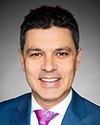In terms of the exploratory fishery development, as I explained earlier, many indicators of lobster presence and abundance gave us the opportunity to proceed directly to the exploratory phase. We also received a lot of information and feedback from the industry.
The exploratory phase will help us check whether the resource can support additional commercial removals in a sustainable manner. We'll need to verify this before we can confirm the long‑term viability of commercial fishing. As with exploratory fishing, exploratory licences are issued for one year only. That way, we can respond to even the slightest negative signals and adjust the plan accordingly to protect the conservation of the resource.



